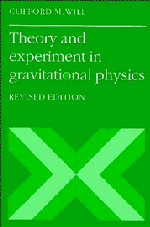Book contents
- Frontmatter
- Contents
- Preface to Revised Edition
- Preface to First Edition
- 1 Introduction
- 2 The Einstein Equivalence Principle and the Foundations of Gravitation Theory
- 3 Gravitation as a Geometric Phenomenon
- 4 The Parametrized Post-Newtonian Formalism
- 5 Post-Newtonian Limits of Alternative Metric Theories of Gravity
- 6 Equations of Motion in the PPN Formalism
- 7 The Classical Tests
- 8 Tests of the Strong Equivalence Principle
- 9 Other Tests of Post-Newtonian Gravity
- 10 Gravitational Radiation as a Tool for Testing Relativistic Gravity
- 11 Structure and Motion of Compact Objects in Alternative Theories of Gravity
- 12 The Binary Pulsar
- 13 Cosmological Tests
- 14 An Update
- References
- References to Chapter 14
- Index
Preface to Revised Edition
Published online by Cambridge University Press: 04 April 2011
- Frontmatter
- Contents
- Preface to Revised Edition
- Preface to First Edition
- 1 Introduction
- 2 The Einstein Equivalence Principle and the Foundations of Gravitation Theory
- 3 Gravitation as a Geometric Phenomenon
- 4 The Parametrized Post-Newtonian Formalism
- 5 Post-Newtonian Limits of Alternative Metric Theories of Gravity
- 6 Equations of Motion in the PPN Formalism
- 7 The Classical Tests
- 8 Tests of the Strong Equivalence Principle
- 9 Other Tests of Post-Newtonian Gravity
- 10 Gravitational Radiation as a Tool for Testing Relativistic Gravity
- 11 Structure and Motion of Compact Objects in Alternative Theories of Gravity
- 12 The Binary Pulsar
- 13 Cosmological Tests
- 14 An Update
- References
- References to Chapter 14
- Index
Summary
Since the publication of the first edition of this book in 1981, experimental gravitation has continued to be an active and challenging field. However, in some sense, the field has entered what might be termed an Era of Opportunism. Many of the remaining interesting predictions of general relativity are extremely small effects and difficult to check, in some cases requiring further technological development to bring them into detectable range. The sense of a systematic assault on the predictions of general relativity that characterized the “decades for testing relativity” has been supplanted to some extent by an opportunistic approach in which novel and unexpected (and sometimes inexpensive) tests of gravity have arisen from new theoretical ideas or experimental techniques, often from unlikely sources. Examples include the use of laser-cooled atom and ion traps to perform ultra-precise tests of special relativity, and the startling proposal of a “fifth” force, which led to a host of new tests of gravity at short ranges. Several major ongoing efforts continued nonetheless, including the Stanford Gyroscope experiment, analysis of data from the Binary Pulsar, and the program to develop sensitive detectors for gravitational radiation observatories.
For this edition I have added chapter 14, which presents a brief update of the past decade of testing relativity. This work was supported in part by the National Science Foundation (PHY 89-22140).
- Type
- Chapter
- Information
- Theory and Experiment in Gravitational Physics , pp. xiii - xivPublisher: Cambridge University PressPrint publication year: 1993

